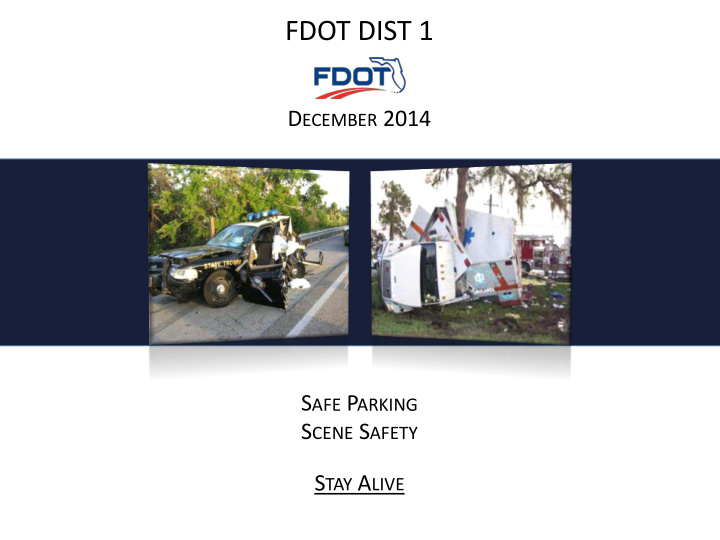



FDOT DIST 1 D ECEMBER 2014 S AFE P ARKING S CENE S AFETY S TAY A LIVE
Typical Vehicle Positioning Upstream Downstream Upstream Downstream • Law Enforcement • Ambulance • Fire • Tow Truck • DOT or Safety Service • Other Support Units Patrol Vehicle 4H-104
Safe-Positioned – MUTCD Definition The positioning of emergency vehicles at an incident in a manner that attempts to: 1. Protect the responders performing their duties 2. Protect road users traveling through the incident scene 3. Minimize, to the extent practical, disruption of the adjacent traffic flow 4H-78
Blocking • Blocking is the action of positioning a responder vehicle in advance of an incident to obstruct the flow of moving traffic in one or more lanes – Linear Block – occurs when a responder positions their vehicle to block a single lane or the shoulder – Multi-Lane Block – occurs when the first responder positions their vehicle to block multiple involved lanes 4H-79
Vehicle Positioning • There are two ways an emergency response vehicle is commonly positioned on the roadway – Angled – Parallel (straight) • Considerations for determining how to position a vehicle include: – Current conditions, such as roadway geometry, sight distance, weather, etc. – Safety of other responders, crash victims, and passing motorists – Impact to vehicle visibility, including vehicle markings and emergency vehicle lighting 4H-81
Typical Vehicle Positioning Upstream Downstream Upstream Downstream • Law Enforcement • Ambulance • Fire • Tow Truck • DOT or Safety Service • Other Support Units Patrol Vehicle 4H-104
Verification • Verification involves collecting sufficient information on the nature of the incident including identifying: – Type and level of incident – Exact physical location – Number of vehicles involved • Color and type if possible – Lanes affected – Injuries, entrapment 4H-62
Initial/Windshield Size-Up • Upon first arriving on-scene, an initial or windshield size-up report should be provided – Confirmation of geographical location – Preliminary analysis of current situation – Actions required to mitigate the situation – Resources required to support those actions • Should take into consideration any unique safety situations apparent to responders as they arrive on-scene 4H-65
Incident Duration Classifications Minor < 30 minutes Intermediate 30 min - 2 hrs Major > 2 hours 4H-70
Lane +1 Blocking – Protected Incident Space 4H-91
Lane +1 Blocking 4H-94
Responder Visibility MUTCD Section 6D.03 states: All workers, including emergency responders, within the right-of-way of a roadway who are exposed either to traffic (vehicles using the highway for purposes of travel) or to work vehicles and construction equipment SHALL wear high- visibility safety apparel… 4H-116
Advance Warning Signs 4H-147
Recommend
More recommend